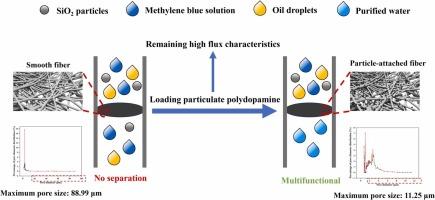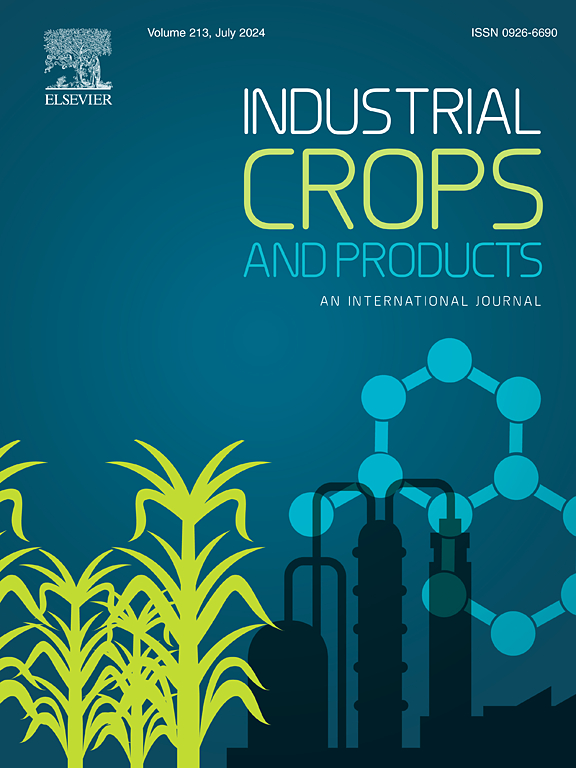固定化聚多巴胺纳米纤维素膜一步法制备多功能油水分离
IF 5.6
1区 农林科学
Q1 AGRICULTURAL ENGINEERING
引用次数: 0
摘要
具有高水通量和多种功能的超润湿膜是工业领域的理想选择。本文提出了一种一步电纺丝策略,利用乙醇延迟多巴胺(DA)的聚合速率,构建含有大量微粒聚多巴胺(PDA)分子的电纺纤维素纳米纤维膜。详细讨论了乙醇对微粒聚多巴胺形成和膜孔径的影响。值得注意的是,锚定在纤维上的亲水性微粒 PDA 增加了表面粗糙度,从而提高了膜的亲水性。此外,随着 DA 用量的增加,膜的孔径减小,而油/水混合物的水通量保持不变。此外,所制备的膜由于其窄孔径分布和高亲水性(水接触角∼0°),可有效分离小粒径油/水乳状液和颗粒物质,分离效率大于 99%。由于 PDA 上的吸附位点,该膜还能分离含有乳化油、颗粒和染料的染色废水。这项工作为解决传统电纺聚合物膜的局限性(如复杂的制备过程、小孔径时的低水通量以及分离多种污染物的能力有限)提供了一种可行的方法。本文章由计算机程序翻译,如有差异,请以英文原文为准。

One-step fabrication of cellulose nanofibrous membrane with anchored particulate polydopamine for multifunctional oil/water separation
Superwetting membranes with high water flux and multiple functions are desirable in industry. Herein, a one-step electrospinning strategy is proposed for constructing electrospun cellulose nanofibrous membranes containing numerous particulate polydopamine (PDA) molecules, using ethanol to delay the polymerisation rate of dopamine (DA). The effects of ethanol on the particulate PDA formation and the membrane’s pore sizes were discussed in detail. Notably, the hydrophilic particulate PDA anchored on the fibres enhanced surface roughness, thus improving the hydrophilicity of the membranes. Moreover, with an increase in the DA dosage, the pore size of the membrane decreased, while the water flux for the oil/water mixture was maintained. In addition, the as-prepared membrane could efficiently separate small-sized oil/water emulsions and particulate matter with separation efficiencies greater than 99 % because of its narrow pore size distribution and high hydrophilicity (water contact angle of ∼0°). Due to the adsorption sites on PDA, the membrane could also separate dyeing wastewater containing emulsified oils, particles, and dyes. This work offers a feasible approach to addressing the limitations of conventional electrospun polymer membranes, such as complex preparation processes, low water flux at small pore sizes, and limited ability to separate multiple types of pollutants.
求助全文
通过发布文献求助,成功后即可免费获取论文全文。
去求助
来源期刊

Industrial Crops and Products
农林科学-农业工程
CiteScore
9.50
自引率
8.50%
发文量
1518
审稿时长
43 days
期刊介绍:
Industrial Crops and Products is an International Journal publishing academic and industrial research on industrial (defined as non-food/non-feed) crops and products. Papers concern both crop-oriented and bio-based materials from crops-oriented research, and should be of interest to an international audience, hypothesis driven, and where comparisons are made statistics performed.
 求助内容:
求助内容: 应助结果提醒方式:
应助结果提醒方式:


